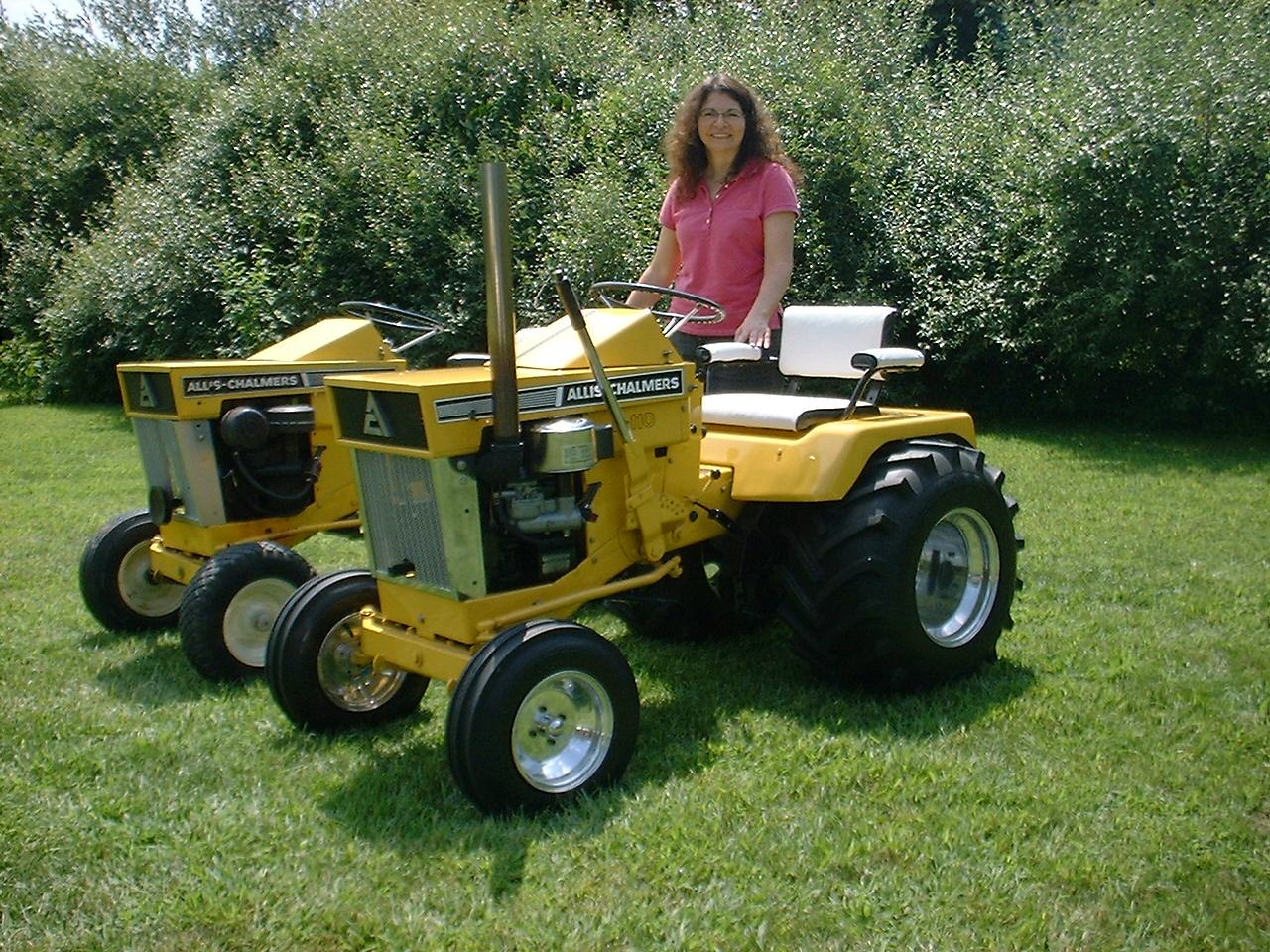| Author |
 Topic Search Topic Search  Topic Options Topic Options
|
tractorman 
Orange Level


Joined: 22 Sep 2009
Location: west central wi
Points: 1046
|
 Post Options Post Options
 Thanks(0) Thanks(0)
 Quote Quote  Reply Reply
 Topic: pulley for generator Topic: pulley for generator
Posted: 11 Oct 2011 at 8:38am |
|
Who has or knows where i can get the smaller pulley that will help my 6 volt generator kick out more volts perhaps enough to charge a 12 volt batter? i know i had this info but can't find it. Tractorman.
|
|
Play on 38 B 49 WF , working on D14, D15 B10, Bee 12 B110. use 185 and 190
|
 |
|
Sponsored Links
|
|
 |
Jeff Z. NY 
Orange Level

Joined: 11 Sep 2009
Points: 7326
|
 Post Options Post Options
 Thanks(0) Thanks(0)
 Quote Quote  Reply Reply
 Posted: 11 Oct 2011 at 9:48am Posted: 11 Oct 2011 at 9:48am |
|
John Brillman has all size pulleys.
The Brillman Company
1-888-274-5562
|
|
I Love Meatballs and Dumplings on Toast with Gravy and Rosemary and ??? {Open For Suggestions}
|
 |
CTuckerNWIL 
Orange Level


Joined: 11 Sep 2009
Location: NW Illinois
Points: 22825
|
 Post Options Post Options
 Thanks(0) Thanks(0)
 Quote Quote  Reply Reply
 Posted: 11 Oct 2011 at 11:09am Posted: 11 Oct 2011 at 11:09am |
|
If your talking about a 3 brush generator, I believe you can adjust the 3rd brush to get a higher output voltage. I can't find the article I read that in though.
|
|
|
 |
Gerald J. 
Orange Level

Joined: 12 Sep 2009
Location: Hamilton Co, IA
Points: 5636
|
 Post Options Post Options
 Thanks(0) Thanks(0)
 Quote Quote  Reply Reply
 Posted: 11 Oct 2011 at 12:45pm Posted: 11 Oct 2011 at 12:45pm |
|
There is a chance that a small alternator (available wide too) pulley will fit the generator shaft. Both use metric bearings.
The third brush in a three brush generator doesn't set voltage, it sets the current. The current through that brush causes armature current to set up a magnetic field that bucks the magnetic field from the field poles and so limits the current. Called Armature Reaction.
For a fixed field current, armature voltage is directional proportional to armature shaft speed. Doubling the shaft speed with fixed field current doubles the armature voltage. True of two or three brush generators.
And for a limited range, armature voltage is a direct function of field current. Until the magnetic circuit saturates, more field current gets more voltage if the shaft speed is held constant. Usually the field of a 6 volt generator is pretty much saturated with about 9 to 10 volts applied to the field coils. So applying more field current/voltage won't increase the armature voltage, but will warm up the field.
Gerald J.
|
 |
Brian Jasper co. Ia 
Orange Level

Joined: 11 Sep 2009
Location: Prairie City Ia
Points: 10508
|
 Post Options Post Options
 Thanks(0) Thanks(0)
 Quote Quote  Reply Reply
 Posted: 11 Oct 2011 at 12:48pm Posted: 11 Oct 2011 at 12:48pm |
Yep, 3 brush generators can be adjusted to up the volts a little. Is there a problem you're trying to fix? If it's cranking on 6v, many folks put new cables on and don't get heavy enough cable. Then it always acts like the battery is run down...
|
|
"Any man who thinks he can be happy and prosperous by letting the government take care of him better take a closer look at the American Indian." Henry Ford
|
 |
Steve in NJ 
Orange Level Access


Joined: 12 Sep 2009
Location: Andover, NJ
Points: 12043
|
 Post Options Post Options
 Thanks(0) Thanks(0)
 Quote Quote  Reply Reply
 Posted: 11 Oct 2011 at 2:12pm Posted: 11 Oct 2011 at 2:12pm |
Most starting problems on six volt systems is either the starter itself that's worn out, undersized cables, tired 6V Battery, or basic connection problems. You really don't want to adjust the third brush to increase output current. All that will do over a period of time is take out the Gennie. Fix the problem in the starting circuit, and put a good 6V Battery in. You won't have any problems. The 6V system is a pretty simple system. It just needs the components in the system up to snuff, and a little TLC once in a while to keep it working at peak performance.
|
 |
Gerald J. 
Orange Level

Joined: 12 Sep 2009
Location: Hamilton Co, IA
Points: 5636
|
 Post Options Post Options
 Thanks(0) Thanks(0)
 Quote Quote  Reply Reply
 Posted: 11 Oct 2011 at 4:12pm Posted: 11 Oct 2011 at 4:12pm |
|
In my experience (starting with a 6 volt car about 60 years ago), cleaning battery posts is a required ritual, as often as twice a year in 6 volt systems, whether used or not. Actually sitting probably means the battery posts (and clamps) need cleaning more often. Clean until the contact surfaces shine, if you use a sturdy knife you will find the dark stuff is HARD and once you get it to shine, the lead alloy is soft. I'm not completely satisfied with most battery post brushes, they aren't aggressive enough to accomplish the complete cleaning. Sometimes they do enough to get the engine started though.
Battery connection protection can be a benefit, like with the red and green felt washers, some grease (vaseline has worked for eons) all over or spray paint, but spray paint won't get the bottom side and a common problem is acid fumes leaking out of the battery around the post. Long ago, battery posts were cast in place so they fully filled the hole in the cover. Many these days are cast in a mold before the cover is installed and there's a gap around the post. That gap is deadly on connectors. I just had to replace a brass one on my F-150 that was corroded and snapped. Brass battery clamps are intended to require replacement they may carry current better when new but at 13 years of age, it went open. And the battery cable is a special with two leads wandering off out of sight. Its fixed without a new battery cable.
Off topic, but I fixed it by cutting the remains of the Ford brass clamp away leaving only the wires, their crimp, and the nut for the clamp bolt. I then drilled a 3/8" hole into the nut that removed its riveting. I bolted a post to side terminal adapter on the battery post and ran a side terminal bolt through that new 3/8" hole and into the end of that terminal adapter. I had to trim a bit of metal from the adapter because the brass was folded in a channel shape. Now I have the brass away from that leaky battery post and further from the battery vents. I didn't buy a $100 Ford cable that takes 3 hours to trace out and install. I carry a spare adapter in the truck at all times now so when the other breaks I might be able to do it on the road.
And as mentioned, 6 volt starter cables need to be FAT closer to thumb than pencil sized, not those carried in the wallyworld battery kiosk which are undersized for starting small 12 volt engines. The limit on battery cable thickness (besides cost) is for it to have enough flexibility to bend to the terminals at each end. Otherwise wrist size would work even better than thumb sized.
As Steve mentioned tired starter. Brushes go first, then bearings. In a starter with worn bushings, the armature WILL eventually drag on a field pole and will crank badly. Repair shops don't usually have a load test that pushes the armature to the side and so are often reluctant to replace bushings. I demand new bushings, brushes, and Bendix and sometimes solenoid when I take a starter in. And I get very fine starting after that. Haven't had to take a starter back the second time. A starter that drags for a while will probably need a new armature as the head from dragging will have destroyed the winding insulation.
Gerald J.
|
 |
DSeries4 
Orange Level


Joined: 12 Sep 2009
Location: Ontario, Canada
Points: 7569
|
 Post Options Post Options
 Thanks(0) Thanks(0)
 Quote Quote  Reply Reply
 Posted: 11 Oct 2011 at 10:17pm Posted: 11 Oct 2011 at 10:17pm |
|
6 volt gennie to charge a 12 volt battery? A 12 volt generator would do a much better job.
|
|
'49 G, '54 WD45, '55 CA, '56 WD45D, '57 WD45, '58 D14, '59 D14, '60 D14, '63 D15D, '66 D15II, '66 D21II, '67 D17IV, '67 D17IVD, '67 190XTD, '73 620, '76 185, '77 175, '84 8030, '85 6080
|
 |
Gerald J. 
Orange Level

Joined: 12 Sep 2009
Location: Hamilton Co, IA
Points: 5636
|
 Post Options Post Options
 Thanks(0) Thanks(0)
 Quote Quote  Reply Reply
 Posted: 12 Oct 2011 at 12:14am Posted: 12 Oct 2011 at 12:14am |
|
6 volt generator puts out 12 volts if turned twice as fast as it did putting out 6 volts with the same field excitation it used for 6 volts. A fundamental of DC machinery, not always understood.
Gerald J.
|
 |









 Topic Options
Topic Options

 Post Options
Post Options Thanks(0)
Thanks(0)




